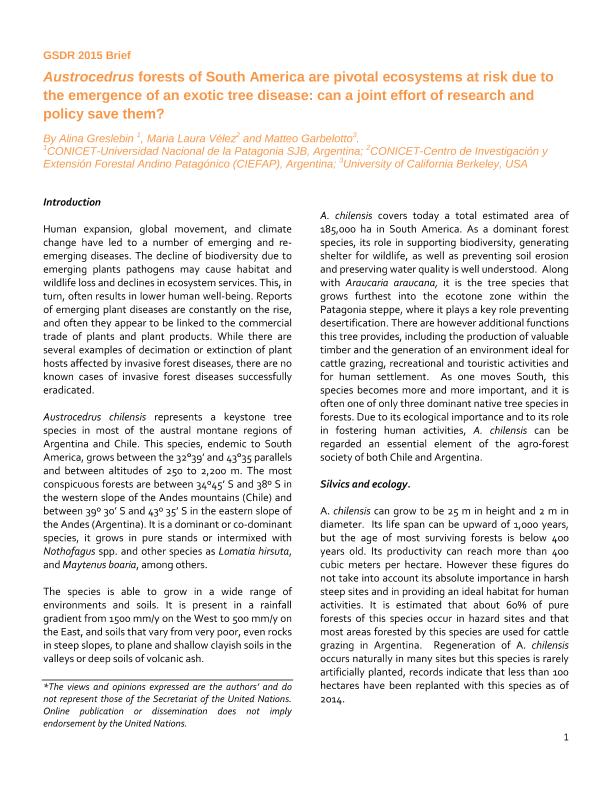Mostrar el registro sencillo del ítem
dc.contributor.author
Greslebin, Alina Gabriela

dc.contributor.author
Vélez, María Laura

dc.contributor.author
Garbelotto, Matteo
dc.date.available
2017-07-24T17:59:08Z
dc.date.issued
2015-03
dc.identifier.citation
Greslebin, Alina Gabriela; Vélez, María Laura; Garbelotto, Matteo; Austrocedrus forests of South America are pivotal ecosystems at risk due to the emergence of an exotic tree disease: can a joint effort of research and policy save them?; Wiley; Natural Resources Forum; 3-2015
dc.identifier.issn
0165-0203
dc.identifier.uri
http://hdl.handle.net/11336/21171
dc.description.abstract
Starting in 1948, significant mortality of A. chilensis was reported in several areas. Disease progression appeared to be fast leading often to 50% mortality, or more, of trees of all ages and size classes. The symptoms included withering, defoliation, and root rot. Patterns of spread of mortality suggested an infectious disease, and the term "Mal del Ciprés" (Cypress disease) was coined to describe the phenomenon. Its causal agent though remained unresolved for over 57 years, despite the several attempts by groups of scientists, including one FAOsponsored expedition whose participants suggested to continue the studies and to investigate the possible participation of a root pathogen. The lack of understanding of the causes behind the Mal del ciprés, greatly hindered any significant advancement in the formulation of preventive and disease control measures. In 2005, a collaboration between Argentine and US scientists led to the discovery of the causal agent of the disease, since then named "Austrocedrus root disease (ARD)". The causal agent was found to be an undescribed soilborne pathogen belonging to the genus Phytophthora, soon to be named P. austrocedri. Although research on novel organisms is extremely complex and demanding, the discovery has led to the understanding of the disease cycle, including some key epidemiological aspects. Currently it is understood that higher infection rates are associated with abiotic factors that favor Phytophthora proliferation and with the proximity to roads and streams, and intensity of grazing. Nine years after the initial discovery, there is little evidence of natural resistance in populations of the tree host, while it has become apparent that humans are responsible, through cattle grazing, vehicular and foot traffic, and construction, for the spread of the disease both in areas adjacent to older infestations and in new areas. Natural preserves and national parks with limited access show no or limited disease. In infested areas, though, mortality can reach 90%, and it has been estimated that P. austrocedri is now present in many sites in at least 3 Argentine states. In 2011, an apparently identical pathogen surfaced in the United Kingdom, where it appears to be causing widespread mortality of a key species of heath and moorlands, Juniperus communis. Although it is still unclear whether the causal agents of the two outbreaks are really the same, the extremely simplified genetic structure of pathogen populations in the two areas suggest both outbreaks are caused by an introduced exotic pathogen, and not by an emergent native one. According to it exotic origin, mitigation measures for ARD should be directed to both the protection of healthy areas, avoiding the introduction of the pathogen, and to the mitigation of disease impact in affected areas.
dc.format
application/pdf
dc.language.iso
eng
dc.publisher
Wiley

dc.rights
info:eu-repo/semantics/openAccess
dc.rights.uri
https://creativecommons.org/licenses/by-nc-sa/2.5/ar/
dc.subject
Phytophthora Austrocedrus
dc.subject
Mitigation Measures
dc.subject
Mal del Cipres
dc.subject
Austrocedrus Root Disease
dc.subject.classification
Otros Tópicos Biológicos

dc.subject.classification
Ciencias Biológicas

dc.subject.classification
CIENCIAS NATURALES Y EXACTAS

dc.title
Austrocedrus forests of South America are pivotal ecosystems at risk due to the emergence of an exotic tree disease: can a joint effort of research and policy save them?
dc.type
info:eu-repo/semantics/article
dc.type
info:ar-repo/semantics/artículo
dc.type
info:eu-repo/semantics/publishedVersion
dc.date.updated
2017-07-20T14:21:25Z
dc.identifier.eissn
1477-8947
dc.journal.pais
Estados Unidos

dc.journal.ciudad
Hoboken
dc.description.fil
Fil: Greslebin, Alina Gabriela. Universidad Nacional de la Patagonia "San Juan Bosco". Facultad de Ciencias Naturales - Sede Esquel; Argentina. Consejo Nacional de Investigaciones Científicas y Técnicas; Argentina
dc.description.fil
Fil: Vélez, María Laura. Centro de Investigación y Extensión Forestal Andino Patagónico; Argentina. Consejo Nacional de Investigaciones Científicas y Técnicas; Argentina
dc.description.fil
Fil: Garbelotto, Matteo. University of California Berkeley; Estados Unidos
dc.journal.title
Natural Resources Forum

dc.relation.alternativeid
info:eu-repo/semantics/altIdentifier/url/https://sustainabledevelopment.un.org/index.php?page=view&type=111&nr=5950&menu=35#
dc.relation.alternativeid
info:eu-repo/semantics/altIdentifier/url/http://onlinelibrary.wiley.com/journal/10.1111/(ISSN)1477-8947/issues
Archivos asociados
